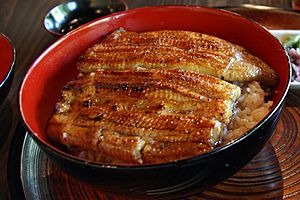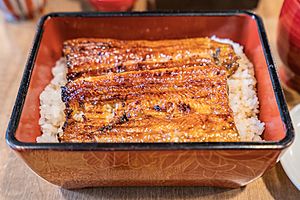Unadon facts for kids
Unadon is a popular Japanese dish. Its name is short for unagi donburi, which means "eel bowl." It's made with a big bowl of steamed white rice, topped with grilled eel fillets. The eel used is called unagi.
The eel is cooked in a special Japanese style called kabayaki. This is similar to teriyaki and involves grilling the eel with a sweet sauce. This sauce, called tare, is made from soy sauce and is sweet. The eel is often grilled over charcoal, which gives it a delicious smoky flavor. The skin side of the eel is placed face down in the bowl. Enough tare sauce is poured over the eel so that some of it soaks into the rice below.
People often sprinkle a spice called sanshō on top of Unadon. It's sometimes called Japanese pepper, but it's not related to regular pepper. This spice adds a unique flavor. Unadon is very popular not only in Japan but also in places like Taiwan and the United States.
Different Kinds of Unadon
There are a few ways to enjoy this delicious eel dish:
- Unajū (鰻重): This is the same dish as Unadon, but it's served in a special, often lacquered, food box called a jūbako.
- Nagayaki (長焼き): With this style, the grilled eel and the rice are served separately, not in the same bowl.
- Hitsumabushi (ひつまぶし): This is a unique way to eat eel, especially popular in the Nagoya area.
There are also two main ways to grill the eel itself:
- Kantō style: In the Kantō region (where Tokyo is), the eel is steamed before it's grilled with the sauce. This makes the eel very soft and tender.
- Kansai style: In the Kansai region (where Osaka is), the eel is grilled directly without steaming first. This makes the eel a bit crispier. You can learn more about these grilling styles under kabayaki.
The History of Unadon
Unadon was the very first type of donburi (rice bowl dish) ever created! It was invented a long time ago, in the late Edo period in Japan, specifically between 1804 and 1818.
A man named Imasuke Ōkubo from a place called Sakai-machi (which is now part of Nihonbashi Ningyōchō in Chūō, Tokyo) came up with the idea. His new dish became very popular in the neighborhood, especially near the famous Nakamura-za and Ichimura-za theaters.
The first restaurant to sell Unadon as a business was probably Ōnoya, located in Fukiyachō. This was likely before 1841, when the theaters burned down and moved away. After a big food shortage in 1844, Ōnoya started selling Unadon for just one Tenpō-sen coin, which made it even more popular.
As for Unajū, the version served in jūbako boxes, some people believe it was created by Gihei, who owned a freshwater fish restaurant called Funagi in Sanya, Asakusa, Tokyo. This restaurant later became known as Jūbako. According to this idea, Unajū was also around in the late Edo period. However, others think Unajū appeared later, during the Taishō era. They suggest that using fancy lacquered boxes made Unajū seem more luxurious. Because of this, Unajū is usually more expensive than Unadon.
See also
 In Spanish: Unadon para niños
In Spanish: Unadon para niños



